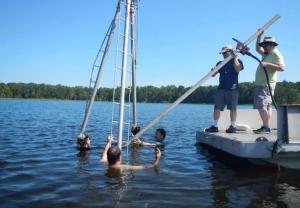The anomalous platinum trail in North America has just confirmed the existence of the space object believed to have caused the last ice age and mass extinction.
Scientists from the University of South Carolina (USA) have found what they call “platinum spikes” in the sediment at White Pond, South Carolina. “Platinum spikes” are an unusual existence of platinum , associated with cosmic objects such as comets, asteroids, and other forms of meteorites.

Scientists are excavating sediment containing “platinum spikes” at White Pond – (photo provided by the research team).
This new discovery adds to the puzzle of platinum anomalies of the same age that have been detected by this team in many parts of the world, including other parts of North America, Europe, Western Asia, Chile, and South Fly.
All this evidence has revealed a cosmic object, be it an asteroid hitting the Earth or a large comet that exploded in the sky some 12,800 years ago. At the same time, the traces scattered across the earth show that it was a global event, not confined to the North American region as previously thought.
The event, which is beautifully named for a flower – Younger Dryas – created dust clouds that covered the earth, blocking sunlight and creating an ice age that lasted 1,400 years. This difficult period led to the extinction of mammoths, saber-toothed tigers, mastodon elephants, giant sloths… and a series of carved creatures.
The event also coincided with a period of severe decline in human populations, which the archaeological evidence of the Clovis culture in the Americas most clearly demonstrates. Thankfully, humanity was able to survive and recover in the end.
Previously, a suspected impact crater with high concentrations of platinum and iridium was discovered near Greenland – the icy Arctic island. Impacts of the same type have been shown to shoot many rare elements and even particles of “meteorite glass” strewn across the Earth.
The study has just been published in Scientific Reports , an issue of the scientific journal Nature.

